ISSN ONLINE(2319-8753)PRINT(2347-6710)
ISSN ONLINE(2319-8753)PRINT(2347-6710)
Raghavendra N1, V S Ramamurthy2
|
| Related article at Pubmed, Scholar Google |
Visit for more related articles at International Journal of Innovative Research in Science, Engineering and Technology
Aluminum 7075 based composites reinforced with alumina (Al2O3) in varying particle size of 100,140 and 200 mesh(149,105 ,74 micron) & varying reinforcement weight fractions of 3%,6%,9% and 12% were prepared. The stir casting process was chosen as the manufacturing route as it is cost effective for mass production. Stirring of the melt was carried out to achieve uniform distribution of the reinforcement Mechanical test like Hardness test, Microstructure characterization and wear study was conducted on the casted composites to know the effect of particle size and weight fraction of reinforcement. Hardness was found to increase with decrease in particle size and it increases as the weight fraction increases. The wear rate and coefficient of friction decreased as the particle size was reduced. But increase in weight fraction reduces both wear rate and coefficient of friction
Keywords |
| Stir casting , Alumina , Al -7075,Weight Fraction , Particle size. |
INTRODUCTION |
| Light weight, high strength & stiffness properties which are desirable for automotive and aircraft industries. This not only reduces the weight of the vehicle but addresses the fuel efficient and greenhouse effect. Development of the new material is growing at the faster rate to reduce the weight and pollution. Metal matrix composites are more widely investigated as research topic for industrial application. The aluminium MMC is developed as an alternative to steel and cast iron owing to high density and weight. |
| From the economical point of view the reinforcement material and processing technique is to be thoroughly researched so that the composite produced will be cost effective for the mass production. The good balance between mechanical properties and the cost of production is the key point in the successful development of composite. The reinforcement added to MMC will be influencing the property of the composite like yield strength, hardness, density and wear behavior based on the wettability ,interface bond strength .The processing route chosen will be influencing the mechanical property based on the agglomeration, particle distribution and segregation. |
| Alumina is considered as the reinforcement material due to its availability and low cost compared to other ceramic material like B4c, ZrC,TiB2, Graphite etc. Ammonia is much more stable in molten state then SiC [1] and more resistant to oxidation. Alumina with MgO coating improves wettability . |
| formation of MgO occurs at high temperature during the melting Al2O3 with Al 7075 which contains 2.5% Mg.The distribution of the reinforcement is achieved by stirring the melt after adding the reinforcement to the matrix. This helps in producing uniform distribution of the reinforcement which gives enhanced mechanical property. The technical aspect concerning the uniform distribution is to be achieved by selection of process parameters like stirring speed, holding time , rate of solidification mold material et c [2]. |
| The composite strength ,stiffness and toughness are affected by reinforcement particle size ,particle adhesion, particle loading in both micro and macro scale [3]. There is a critical particle size below which the yield strength and compressive strength are greatly enhanced. Alumina as reinforcement with Al-6061was studied which reveals that with increase in temperature the wear reduces [4] .The Mechanical property of the composite like strength and stiffness are found to improve with variation in the reinforcement weight fraction. Density of the composite increases with increase in weight percentage of the reinforcement in case of Al 2024 –Al2O3 material system [5]. |
| The present work focuses of the improvement of the particle distribution to achieve desired mechanical property by stir casting route. Development of the composite system with different reinforcement particle size and weight percentage .Finally evaluation of the influence of particle size and weight percentage on the Hardness, wear and strength of the composite. |
EXPERIMENTAL |
| Matrix and Reinforcement Material-The Matrix material used in this study is aluminum 7075-T6 supplied by M R Aluminum, Bangalore. The properties and the composition of the matrix material is shown in table 1.The reinforcement used is alumina (Aluminum oxide –active) supplied by Rolex Ltd.The composition and properties of the matrix and ceramic reinforcement is shown in table 1&2. |
 |
| The table showing composition of the alloy indicates the zinc as the major alloying elements in7xxx series. The 7075 alloy series contains Zinc as the major alloying element at 5.1 to 6.1 %.The Magnesium content is between 2.1 to 2.9.This type of alloy are presently used for aircraft wing structure and wing stiffener . The material in the T6 heat treatment condition possess excellent fatigue and tensile strength. The tensile strength of |
 |
| The table 2 indicating the properties of the alumina ceramic shows that the hardness value of 2017 which is more than 15 times the AL-7075 alloy. The density of the ceramic is close to that of the matrix without too much deviation . |
| The Al 7075 was in the form of rectangular bar of 20mmX25mm of length 1000mm which was cut from the same dimension thickness rolled plate. The aluminum was finally cut in to pieces of 20mmX25mmX100 mm bars to place inside the crucible. The alumina powder was subjected to sieve analysis to separate the powder according to particle size .The powders collected in the sieve corresponding to 100mesh, 140mesh and 200 mesh were used in the present work. The separated particle corresponds to 149 micron (100 mesh), 105 micron (140 mesh) and 74micron (200 mesh). The reinforcement weight was 10%. corresponding to each particle size 100gms were weighed and stored separately. The weight of 100 gms reinforcement and 900 gms matrix was considered for 1kg composite Another set of Al2O3 were measured corresponding to weight fractions of 3%,6%,9%and 12% of particle size 50-150micron.The corresponding weight for the each samples were 30gms(3%),60gms(6%),90gms(9%) and 120gms (12%) for 1kg composite. |
| Aluminum 7075 was taken in the form of bars of 100mm length and weighed according to requirement , thoroughly washed to remove oil, grease, impurities on the surface then dried and placed in the graphite crucible. The temperature of the furnace was raised to 720°C .The alumina powder was initially heated to 350°C separately to remove moisture. The reinforcement was added to the melt slowly through the crucible wall. The melt is stirred with the alumina rod thoroughly for 5 min as shown in fig1. |
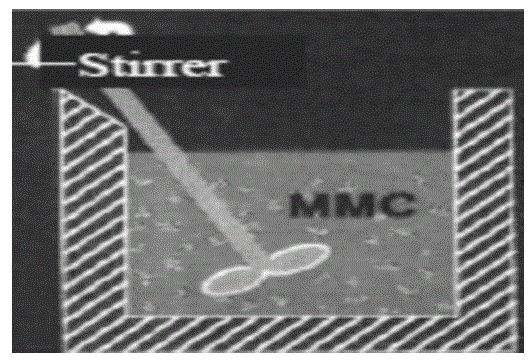 |
| The stir casting furnace consists of crucible used for melting the matrix material ,it is made of graphite or steel. The stirrer in the form of circular rod was used which is having sufficient length to dip in to the metal mould and can be stirred by holding it from out side the furnace. |
| The melt was poured in to the sand mold to get the castings of 20mm diameter and 200mm length. The casted specimen were turned to reduce the diameter from 20mm to 18mm and samples of length 40mm were cut for the hardness test. The specimen of diameter12 mm and length 30mm were machined for wear test. The prepared specimen was subjected to grinding and then polishing with emery sheet of 200,600,1200 grit , finally polished with diamond paste and etched. The specimen was observed under microscope . The microstructure obtained under different magnification was shown in fig 2 . |
| The micrograph shown in fig 2 a indicates the pure al 7075 alloy which indicates only grain boundary of the castings without any particles. The subsequent microstructures shown in b,c,& d for varying microstructure indicates the presence of the reinforcing particles. The amount of the particles in the micrograph shows that increase in particle size will produce clusters to some degree compared to lower particle size. |
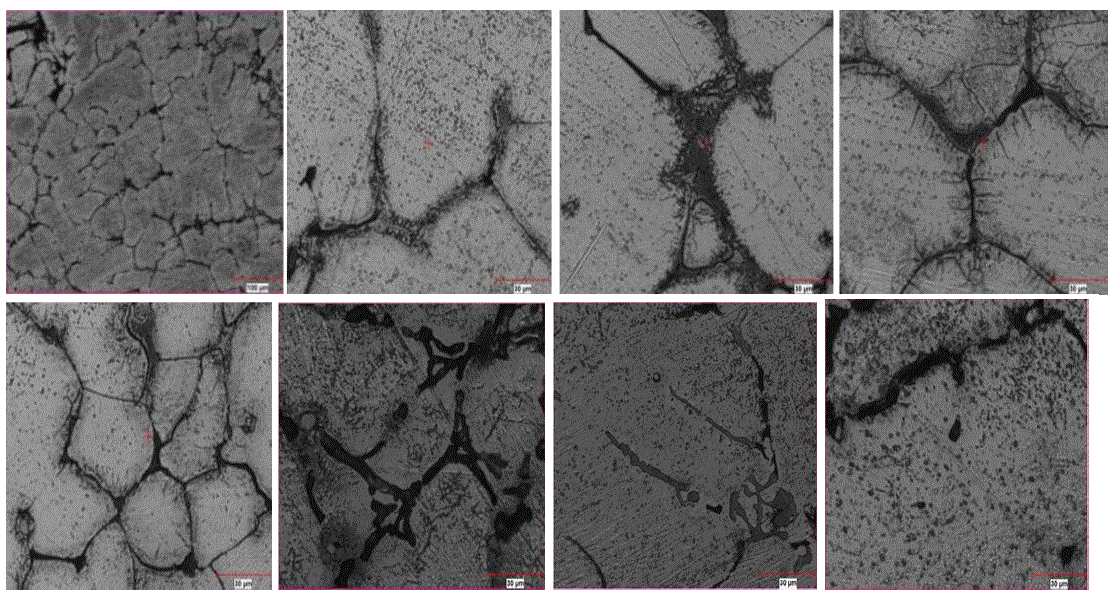 |
 |
| Fig 2 Optical Micrograph of specimen with varying particle size and varying weight fraction of reinforcement a) Pure aluminum alloy in as cast state without any dispersion. b) Al 7075 reinforced with 100 mesh size particle with uniform distribution c) Al 7075 reinforced with 140 mesh size particle with moderate uniformity d) Al 7075 reinforced with 200 mesh size particle least uniformity . e) Al 7075 reinforced with 3%weight fractionwith uniform distribution f ) Al 7075 reinforced with 6% weight fraction with least amount of particle cluster of particles g ) Al 7075 reinforced with 9% weight fraction with moderate cluster of particles h) b) Al 7075 reinforced with12% weight fraction with high increased clustering of particles. |
| Brinell hardness and Vickers hardness test were carried out on the composite material. For the brinell test ball diameter of 5mm and load 250kg was used .in Vickers hardness test load of 5kg for 10 min duration was applied. Three trials were taken and average value was used. The values of hardness test are plotted and shown in fig 3. |
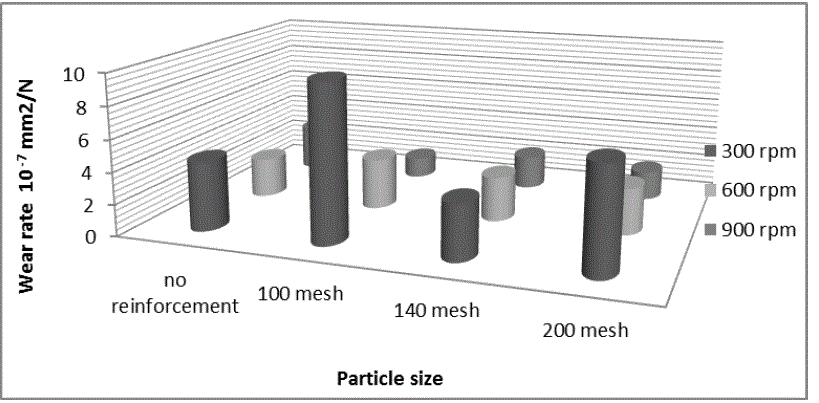 |
| The hardness variation in the fig 3 indicates as the particle size increases the BHN found to decrease . The maximum value of BHN obtained for higher particle size found to be 96. |
| Pin on disc is the most widely used wear test to measure the weight-loss, wear rate of different material followed by pin on flat. Other application of the pin on disc machine include wear measurement at elevated temperature, in presence of lubricant and in vacuum. In this study pin on disc wear test was carried out on the composite in dry wear condition. The disc material used is En-30 steel with hardness 60HRC and surface roughness 1.3Ra.the wear track diameter was chosen suitably. The pin on disc wear test confirms to ASTM G99 standards. The DUCOM wear tester supplied by DUCOM, Bangalore was used for the test. The machine had the facility of digital display of wear volume and friction force by electronic force sensor and LVDT. The variation of the wear and coefficient of friction was plotted automatically by winducom software. Adhesive wear test were carried out on the specimens at varying speed of 300,600,900 rpm and the variation of wear rate is shown in fig 4&5. |
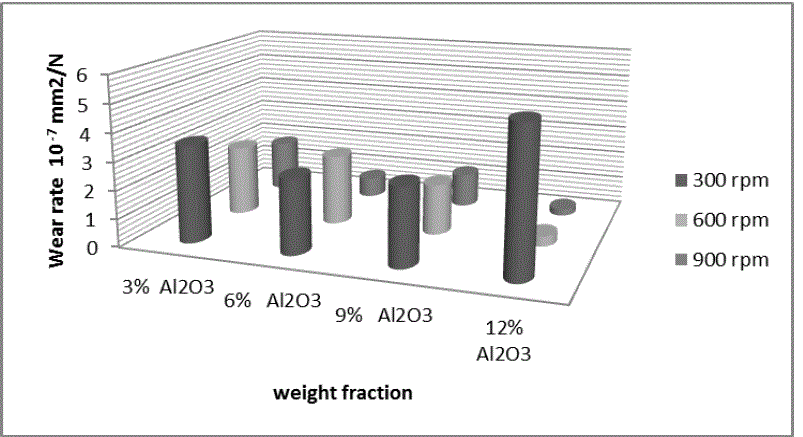 |
| The figure 4 and 5 indicating the variation of wear rate confirms that the highest wear rate is obtained for the lower particle size. The highest wear rate also found for the specimen with higher weight fraction. The 12% reinforced MMC indicates improved wear rate as indicated above.at lower speed the wear rate was significantly higher due to more contact area and high friction. |
| Similar wear test are conducted by varying the load of 2,4,6,8 kg and its effect on the wear rate is shown in fig 6&7. The variation of the wear rate for sliding distances of 2,4,6km are plotted and shown in fig 8&9. |
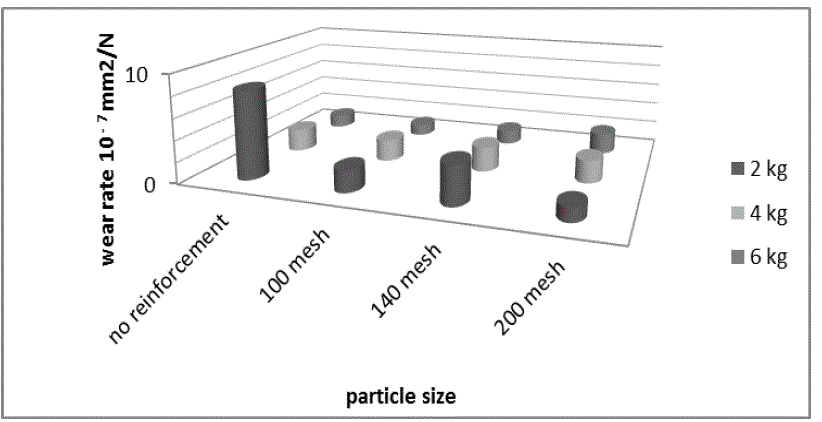 |
| The above fig clearly indicate the influence of the weight fraction and particle size of the reinforcement on the wear behaviour of the composite .The wear rate reduces with reduction in particle size at lower load. Similarly the wear rate reduces with increase in weight fraction at lower load. |
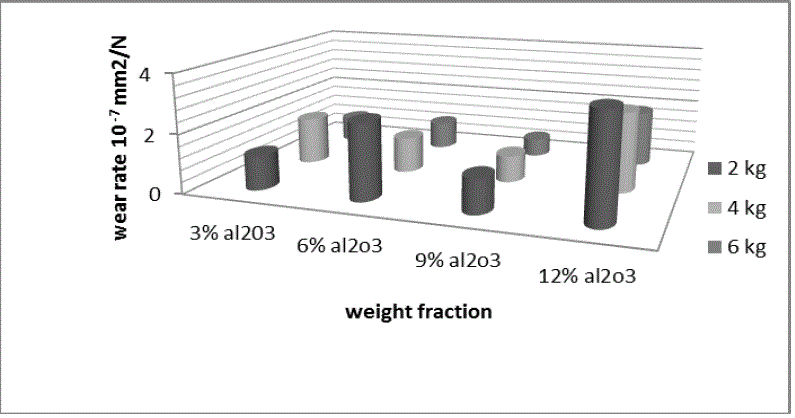 |
III. RESULTS AND DISCUSSION |
| Melting of aluminum matrix was carried out at the optimum temperature of 720º so that the proper viscosity is achieved which provides better distribution of the particles. As the melt attains the higher temperature above 750º particles will sink and get settled at the bottom during melting and pouring. If the temperature of the melt becomes less than 680º the melt becomes more viscous and the particles will float over the melt surface. The optimum temperature range during pouring also maintained at 720º .The stirring has to be carried out till pouring to avoid the particle clustering. Placing the mold cavity vertical position will help to reduce the porosity .The sand mold provides steady cooling to reduce agglomeration. |
| The hardness vs Particle size graph indicates that there is an improvement in the hardness due to variation of particle size .the hardness increases as the particle size reduces this is due to more closely packed reinforcement particle in the matrix. The hardness is expected to increase if nano-particles art used. The interface area is inversely proportional to particle size or average diameter. |
| The wear rate was found to reduce with the increase in the speed. Also for a given speed the wear rate reduces for the reduction in the particle size ,therefore specimen with 200 mesh(74micron)has lower wear rate compared to 100mesh(149micron) particle size. This is due to the interaction of the alumina particle with the disc is more and surface area of contact of reinforcement is enhanced with reduction in particle size. As the particle size reduces the interface bonding will be more stronger which reduces wear rate. The variation of load influences the wear rate in inverse proportion so that wear reduces with increase in load. Similar effect was observed for all types of particle size of reinforcement used. This is due to hard abrasive particle tend to plough the surface of the counter body. |
| Coefficient of friction is the other parameter to be investigated in wear behavior of MMC which influences the wear rate. But the variation of the coefficient of friction is to be estimated in conjunction with the surface roughness. The speed, load variations will affect the coefficient of friction .It is clearly observed from figures 6,8,10 that hardness increases for the specimen with increase in weight fraction of the al2o3 reinforcement .Although there is no clear standard behavior the composite with reference to hardness in varying weight fraction but general observation is hardness increases with increase in reinforcement. Wear rate for the specimen with higher weight fraction will be higher and also wear rate reduces as the speed increases. |
IV. CONCLUSION |
| The mechanical properties of the MMC are controlled by number of parameter like processing route ,reinforcement size, weight faction etc. The molten metal temperature is the key factor for the indication of the uniform distribution of the particle. The viscosity of the molten metal is controlled by the melting temperature in the furnace, therefore it is required to maintain the temperature of 700 º to 720º C to avoid the agglomeration and clustering. |
| The hardness of the composite was found to increase with reduction in the particle size and the wear rate for varying particle size reduces with reduction in particle size. The wear rate also reduces with increase in the weight fraction of the reinforcement. But at an optimum value of the weight percentage of 20% the maximum reduction in the wear rate is achieved further increase in the reinforcement will not have further reduction in the wear rate. |
References |
|